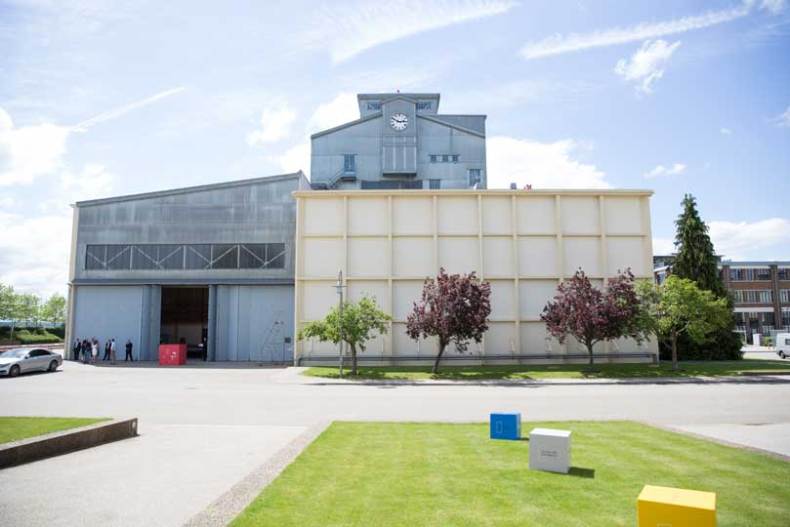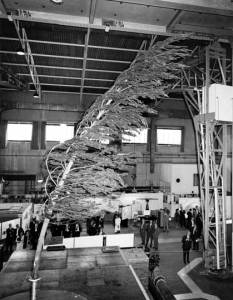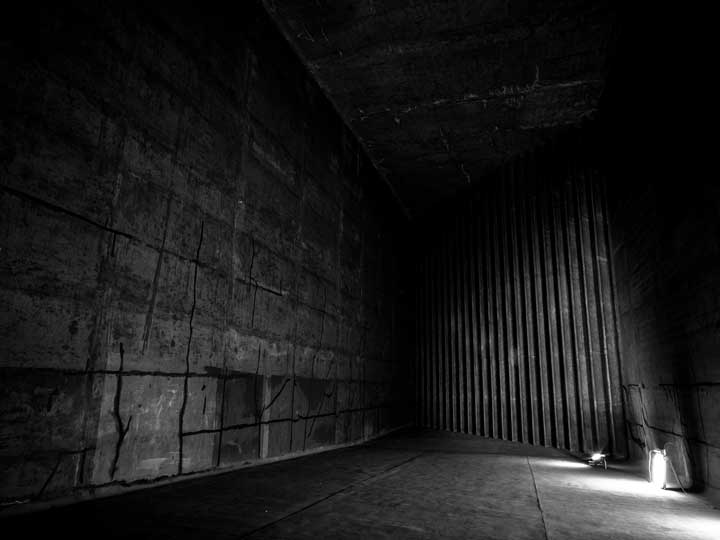The surroundings really don’t promise much. But in a business park in the outer reaches of London’s commuter belt is the Wind Tunnel Project, one of the most unusual, imaginative and remarkable art projects in recent years.

The Wind Tunnel Project: outside R52 looking at Q121. Courtesy of Artliner
This unprepossessing site was once home to RAE Farnborough, the British Government’s main testing ground for new and experimental aircraft. To get a sense of its importance, it was here that former Wild West showman Samuel Cody made the first powered flight in the history of British aviation in 1908. More recently, this was where work was carried out on the development of everything from the Spitfire to Concorde, but its importance began to decline after the 1960s. Bit by bit, it was decommissioned.

24ft tunnel (1967) Courtesy of Artliner and Farnborough Air Sciences Trust
Today, according to Artliner founder Tatiana Ojjeh, who initiated the project, only 3% of the original site remains. The original testing centre – much of which is now, appropriately, occupied by Farnborough airport – must have been the size of a small town. Not including the airship hangar – an enormous, toaster-shaped metal skeleton that was re-built on the site in 2006 – only three structures from the original site remain, all of which are now listed.
One of them remains firmly sealed off, its walls coated in asbestos, but after two years of work, Artliner and the V&A’s Salma Tuqan have finally managed to open the other two up to the public. This is the first instalment of what they hope will be a bi-annual exhibition. Wary of trying to impose on the extraordinary site, they have commissioned a handful of artists to create site-specific sound and light work that is particularly sensitive to its surroundings.
The older of the two buildings, R52, contains Britain’s oldest wind tunnel, built in 1917. Here, between the multiple levels and sets of equipment that support this impressive bit of engineering, artist James Bridle has installed a sinister video of a jet using surveillance footage from a drone. Given the level of secrecy that surrounded the RAE, (all signal communication and documents were issued in code) it’s an appropriate and interesting work, an indirect continuation of the technology pioneered here.

Air return duct Q121. Courtesy of Artliner
Click here for more images of The Wind Tunnel Project
But the real draw is Q121, the other building. Built in 1935, it contains what is still Britain’s largest wind tunnel. That fact alone can’t quite prepare you for the sheer enormity of it; the fan is 24ft in diameter, while the return air duct is just over 40ft tall. One could reel off otherworldly comparisons: it’s like something from Space Odyssey; no, wait – Star Wars; you could spend weeks gawping.
Still, no photograph or description can do justice to what lies inside the turbine itself. After crouching through a small door and find yourself in darkness punctuated only by phalanges of orange light, which punch through the shutters of the fan chamber. Feeling one’s way around is bizarre – because every detail has been refined to maximise the circulation of air, gradients are not what you expect them to be. Even the joints between the walls and the floor have a satisfying curve. Denied the power of sight, negotiating the space is a satisfyingly haptic task.
You can walk onto the fan itself – looking out between the propellers is like gazing off a cliff top. Turn to the right of the entrance and you enter a room of such total darkness that the light shining through can’t penetrate it – the walls don’t reflect a thing. Staring into this void as the birdsong of Thor McIntyre-Burnie’s sound installation chirps away is both terrifying and tranquil.
Tuqan and Ojjeh make much of this turbine’s ‘cathedral-like’ qualities: to my eyes, it’s more like the sort of otherworldly space Andrei Tarkovsky conjured in his film Stalker. Much credit must go to McIntyre-Burnie’s birdsong installation, which conditions visitors to approach the space more carefully. But really, the near-spiritual experience it fosters is down to the architecture itself – it’s no stretch to claim this as one of the most astonishing structures in Britain.
The Wind Tunnel Project is open in Farnborough, Hampshire, until 20 July.

Extraordinary structures: The Wind Tunnel Project in Farnborough
Wind turbine Q121. Courtesy of Artliner
Share
The surroundings really don’t promise much. But in a business park in the outer reaches of London’s commuter belt is the Wind Tunnel Project, one of the most unusual, imaginative and remarkable art projects in recent years.
The Wind Tunnel Project: outside R52 looking at Q121. Courtesy of Artliner
This unprepossessing site was once home to RAE Farnborough, the British Government’s main testing ground for new and experimental aircraft. To get a sense of its importance, it was here that former Wild West showman Samuel Cody made the first powered flight in the history of British aviation in 1908. More recently, this was where work was carried out on the development of everything from the Spitfire to Concorde, but its importance began to decline after the 1960s. Bit by bit, it was decommissioned.
24ft tunnel (1967) Courtesy of Artliner and Farnborough Air Sciences Trust
Today, according to Artliner founder Tatiana Ojjeh, who initiated the project, only 3% of the original site remains. The original testing centre – much of which is now, appropriately, occupied by Farnborough airport – must have been the size of a small town. Not including the airship hangar – an enormous, toaster-shaped metal skeleton that was re-built on the site in 2006 – only three structures from the original site remain, all of which are now listed.
One of them remains firmly sealed off, its walls coated in asbestos, but after two years of work, Artliner and the V&A’s Salma Tuqan have finally managed to open the other two up to the public. This is the first instalment of what they hope will be a bi-annual exhibition. Wary of trying to impose on the extraordinary site, they have commissioned a handful of artists to create site-specific sound and light work that is particularly sensitive to its surroundings.
The older of the two buildings, R52, contains Britain’s oldest wind tunnel, built in 1917. Here, between the multiple levels and sets of equipment that support this impressive bit of engineering, artist James Bridle has installed a sinister video of a jet using surveillance footage from a drone. Given the level of secrecy that surrounded the RAE, (all signal communication and documents were issued in code) it’s an appropriate and interesting work, an indirect continuation of the technology pioneered here.
Air return duct Q121. Courtesy of Artliner
Click here for more images of The Wind Tunnel Project
But the real draw is Q121, the other building. Built in 1935, it contains what is still Britain’s largest wind tunnel. That fact alone can’t quite prepare you for the sheer enormity of it; the fan is 24ft in diameter, while the return air duct is just over 40ft tall. One could reel off otherworldly comparisons: it’s like something from Space Odyssey; no, wait – Star Wars; you could spend weeks gawping.
Still, no photograph or description can do justice to what lies inside the turbine itself. After crouching through a small door and find yourself in darkness punctuated only by phalanges of orange light, which punch through the shutters of the fan chamber. Feeling one’s way around is bizarre – because every detail has been refined to maximise the circulation of air, gradients are not what you expect them to be. Even the joints between the walls and the floor have a satisfying curve. Denied the power of sight, negotiating the space is a satisfyingly haptic task.
You can walk onto the fan itself – looking out between the propellers is like gazing off a cliff top. Turn to the right of the entrance and you enter a room of such total darkness that the light shining through can’t penetrate it – the walls don’t reflect a thing. Staring into this void as the birdsong of Thor McIntyre-Burnie’s sound installation chirps away is both terrifying and tranquil.
Tuqan and Ojjeh make much of this turbine’s ‘cathedral-like’ qualities: to my eyes, it’s more like the sort of otherworldly space Andrei Tarkovsky conjured in his film Stalker. Much credit must go to McIntyre-Burnie’s birdsong installation, which conditions visitors to approach the space more carefully. But really, the near-spiritual experience it fosters is down to the architecture itself – it’s no stretch to claim this as one of the most astonishing structures in Britain.
The Wind Tunnel Project is open in Farnborough, Hampshire, until 20 July.
Unlimited access from just $16 every 3 months
Subscribe to get unlimited and exclusive access to the top art stories, interviews and exhibition reviews.
Share
Recommended for you
Review: Lost Kingdoms: Hindu-Buddhist Sculpture at the Metropolitan Museum
Packed with treasures, this exhibition will be hard to top
Gallery: ‘The Pure, Simple and Natural’ at the Uffizi Gallery
A few highlights from the Uffizi Gallery’s latest exhibition
First Look: ‘British And German Art After 1945’ at the Sprengel Museum Hannover
A curator’s introduction to the Sprengel Museum’s upcoming exhibition